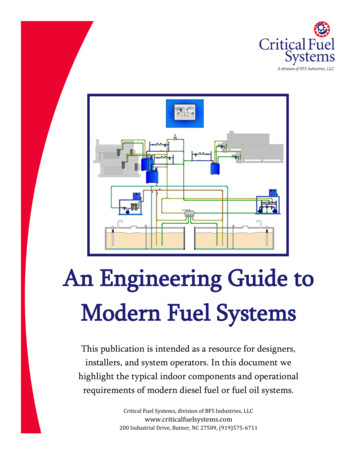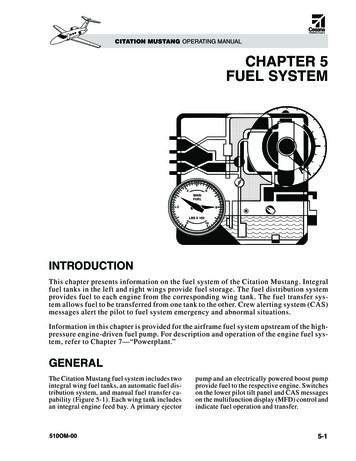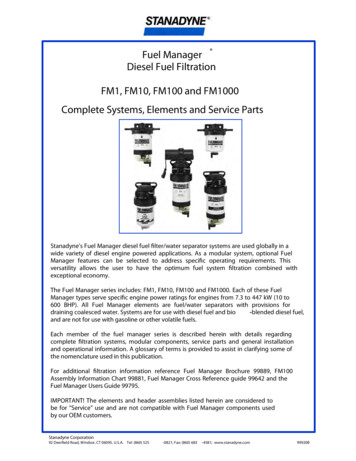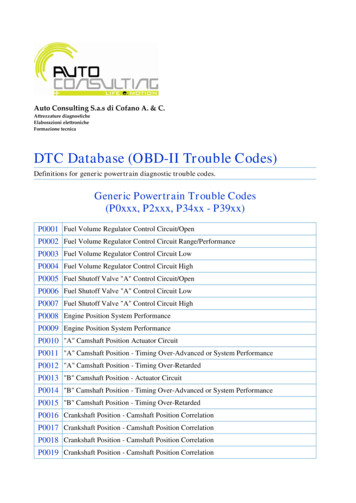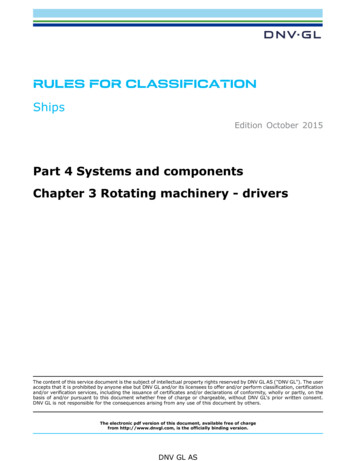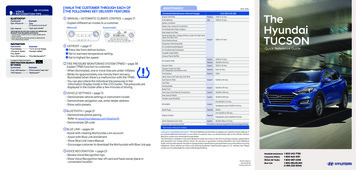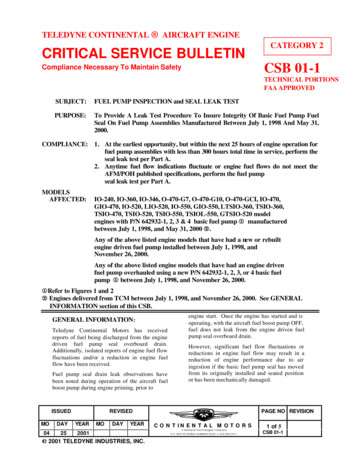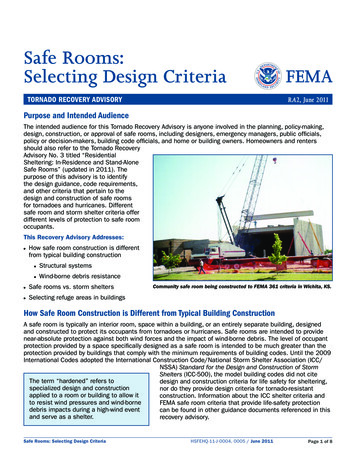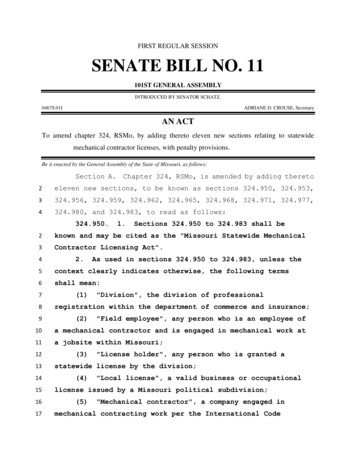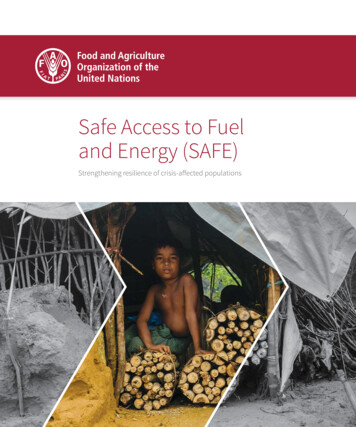
Transcription
Safe Access to Fueland Energy (SAFE)Strengthening resilience of crisis-affected populations
Photo cover: FAO/Sergio Rivero
FAO/C. SpencerCommunication is key tochanging behaviour forimproved access to cleancooking energy.Photo: Mural painting promoting safecooking technologies in Akobo, Jongleistate (South Sudan).Crisis-affected populations – including refugees, internally displaced andthe communities hosting them – often have severely constrained access tofuel and energy for cooking, heating, lighting and powering. FAO is workingwith partners through the Safe Access to Fuel and Energy (SAFE) initiativeto address energy needs during emergencies and protracted crises, and tobuild resilient livelihoods in a sustainable manner.Adequate access to fuel and energy is vital for people’s health, well-beingand livelihoods. Limited access heightens the risks of malnutrition, spoiledfood, respiratory diseases, environmental degradation, conflict andunsustainable, precarious livelihood activities such as charcoal making orwood selling. Women and children usually bear the burden of collectingwood increasing their workload and the risk of gender-based violence.For instance, recent field assessments have shown that women spendon average per week 14 hours collecting wood in Cox’s Bazar campsBuilding resilience of crises-affected populations 1
(Bangladesh), 18 hours in Bidibidi camp (Uganda) and 21 hours in campsaround the city of Goré (Chad). FAO/C. SpencerIn implementing the SAFE initiative, FAO adopts a multi-sectoral approachto respond to these diverse challenges. FAO’s work in this area can haveimportant multiplier effects – from better food security, nutrition andhealth, to the sustainable management of natural resources, greaterresilience to climate change and natural hazards, and increased livelihoodopportunities.Traditional mud stove in Nimule (ImatongState, South Sudan).FAO’s work in this area canhave important multipliereffects – from better foodsecurity, nutrition andhealth, to the sustainablemanagement of naturalresources, greater resilienceto climate change andnatural hazards, andincreased livelihoodopportunities.2 Safe Access to Fuel and Energy (SAFE)FAO’s work on SAFE has gained momentum in recent years, due in partto the increased recognition of the importance of energy issues forcrisis‑affected populations, both in the field and in major global policyprocesses, such as the 2030 Agenda for Sustainable Development, theWorld Humanitarian Summit, and the Global Plan of Action for SustainableEnergy Solutions in Situations of Displacement. SAFE also figuresprominently in FAO’s strategic programme to increase livelihood resilienceto threats and crises (SP5) that affect agriculture, food and nutrition.FAO engages in inter-agency coordination through the SAFE HumanitarianWorking Group, which seeks to facilitate a more coordinated,predictable, timely and effective response to the fuel and energy needsof crisis‑affected populations. Together with UNHCR, FAO has publisheda joint technical handbook on assessing woodfuel supply and demandin displacement settings, and has carried out joint assessments inBangladesh, Chad, Djibouti, Ethiopia, Kenya, Myanmar, Nigeria, Somalia,South Sudan, the United Republic of Tanzania and Uganda.There is growing awareness of the importance of including sustainableenergy access activities in humanitarian appeals and programming, aswell as in protracted crisis settings. As such, SAFE is being incorporatedinto larger resilience-building projects and programmes. Despite thismomentum, more adequate, reliable funding and strategic partnershipsare needed to meet the energy needs of the world’s most vulnerablepopulations.
FAO/GMB AkashSnapshotsof FAOprogrammesReducing woodfuel use through cleancooking technologies such as LPG reducesthe work burden of women and childrencollecting wood like Rohingya refugees inthe area around Cox’s Bazar (Bangladesh).BangladeshIn Cox’s Bazar, FAO provides immediate support to address the cookingfuel crisis, which has become a “crisis within a crisis” due to thedisplacement of Rohingya refugees. FAO works with partners to pilotLiquefied Petroleum Gas (LPG) provision amongst a targeted groupof newly arrived refugees and host community members togetherwith training on nutrition in order to ease possible tension betweencommunities on natural resources management. FAO also supportsthe land stabilisation and reforestation efforts of the Bangladesh ForestDepartment.Building resilience of crises-affected populations 3
FAO/C. SpencerEthiopiaThree-stone fires are energy-inefficient,unhealthy and consume large quantities ofwoodfuel. The SAFE approach in Ethiopiacombines energy-efficient technologieswith support to multi-purpose treeplantations.FAO is working to sustainably address the energy needs of crisis-affectedhouseholds in and around refugee camps. This includes surveying andmapping woody biomass resources and assessing woodfuel consumptionand energy efficiency of cooking systems in refugee camps. FAO aimsto improve the social aspects of forests, encourage private forestdevelopment, disseminate forest development technology and moderninformation systems, and enhance the market for forest products. Thenumber of hectares of multi‑purpose tree plantations targeted increased,and an estimated 2 200 rural households were supported with energyefficient technologies. FAO/A. ThulstrupKenyaDistribution of woodfuel, such as this one,to refugees in Kenya has short-term effectson meeting the immediate fuel needs ofpopulations but major impacts on the localenvironment if fuel-efficient strategies arenot implemented.FAO strengthened linkages and supported dialogue between refugee andhost communities in Kakuma and Kalobeyei camps (Kenya) to improveincomes, food security and nutrition. The project supported more than400 charcoal producers from the host community to improve the processefficiency, contributing to building resilience. Refugees buy the charcoalproduced by the host community. The monthly income of host communityhouseholds has increased by 84 percent and income of refugee householdsby 15 percent. FAO also provided 8 000 dual-purpose stoves (charcoal andwood) to both refugee and host communities. Women and youth refugees’exposure to protection risks whilst collecting fuel have been significantlyreduced. FAO/A.ThulstrupNigeriaIn Maiduguri (Nigeria), the support to thetree nursery together with the provisionof fuel-efficient stoves has the potential torestore the local environment and providelivelihood support to local populations.4 Safe Access to Fuel and Energy (SAFE)In northeast Nigeria, FAO is enhancing the resilience of crisis affectedpopulations. Improved energy access and land rehabilitation are one ofthe pillars of this approach. FAO is assessing woodfuel supply and demanddynamics, supporting the local production of fuel-efficient stoves and zeerpots, reinforcing tree nursery establishment and management, promotingimproved fish smoking technologies and providing 2 500 SAFE kitscomprising of portable, durable and lightweight stoves and solar lanterns forhighly mobile internally displaced and returnee households. The approachlinks crisis-response mechanisms with improved livelihood through thelocal production of 3 000 fuel-efficient stoves in three manufacturing centres.
FAO/Florent EveilléSomaliaThe production of fuel-efficient stoves hasan important multiplier effect on livelihood,environment, food security and nutrition. InSomalia, different professions benefit fromtrainings on the production of such stoves.In Somalia, FAO is supporting energy security and more resilientlivelihoods by gradually reducing the unsustainable production, tradeand use of charcoal. Activities include promoting alternative sourcesof energy and livelihoods for charcoal value chain beneficiaries, as wellas reforestation and afforestation. In addition to sustainable naturalresources management, FAO is training women and young people inmetalworking, clay moulding, stove assembly and marketing. Finally FAOsupports the development of business models for small-scale energyservices and products. FAO/C. SpencerSouth SudanThe burden of wood collection is primarilyshouldered by women who spend 15 hoursper week on average collecting wood.In 2017, FAO provided 30 000 emergency livelihood kits to crisis-affectedpopulations comprising fuel-efficient stoves in camps, improvised settlementsand host communities. FAO also trained households on fuel-saving cookingpractices and stoves use in order to ease pressure on natural resources, reducepossible tension between communities, and to help protect women fromviolence associated with collecting firewood. Given the concentrated demandfor fuel, efforts are also being made to decrease the pressure on forests andwoodlands in displacement settlements by promoting improved pruningtechniques for the selective collection of firewood. FAO/J. CendonThe SudanIn the Sudan, the production offuel‑efficient stoves improves livelihood,decreases work burden and helps the localenvironment to recover due to a reductionof wood collection.In the Sudan, FAO is working to save lives, improve food security andstrengthen the livelihoods of South Sudanese refugees and the mostvulnerable host community members. It is also helping to reduce theimpact of wood collection in the areas surrounding refugee camps andsettlements in White Nile State. Around 700 women and 300 girls from theSouth Sudanese refugee community have been trained on the productionand use of fuel-efficient stoves. FAO also aims to reduce poverty andensure the food security and nutrition of marginal and small ruralhouseholds and ex‑combatants. Activities include boosting agriculturaland livestock production, improving natural resources management andenhancing income-generating opportunities in natural disaster‑proneBuilding resilience of crises-affected populations 5
areas in the East. Climate change mitigation activities include treeplanting, training of households to care for planted seedlings andagroforestry practices. FAO/Tawfic KhwiesSyrian Arab RepublicSupported by FAO, biogas production inthe Syrian Arab Republic provides aviable solution to the energy needs ofsixty vulnerable households.Due to the ongoing crisis, the high dependence on woodfuel in theSyrian Arab Republic, especially in rural areas, is resulting in an alarmingrate of deforestation.FAO supports crisis affected households and communities to strengthentheir resilience to food insecurity. Activities focus on developingthe agriculture crop production and natural resource managementcapacities and access to alternative income sources of targetedpopulations. FAO supports the construction of household biogasdigesters in order to improve energy access of the targeted populationsand improve the local environment. FAO/A. Al Shara’abiYemenThe installation of solar pumps in Yemenhas improved livelihoods by improvingagricultural productivity and domesticwater uses.6 Safe Access to Fuel and Energy (SAFE)Acute fuel shortage in Yemen has a deep impact on household livelihoodsparticularly on health, transport and agriculture. FAO supports theinstallation of solar photovoltaic pumps to ensure continuous waterprovision to rural households for domestic use, support to crop and fodderproduction and livestock watering. Cold chain equipment is also providedto ensure safety of the livestock value chains.
FAO/Arete/Will Baxter
FurtherresourcesFAO. 2018. Building resilience through Safe Access to Fuel and Energy(SAFE). Rome, FAO. 62 pp.(also available at http://www.fao.org/3/CA0021EN/ca0021en.pdf)FAO. 2016. Guidance Note: Meeting fuel and energy needsin protracted crises. The SAFE approach. Rome, FAO. 28 pp.(also available at www.fao.org/3/a-i6633e.pdf)FAO and UNHCR. 2016. Assessing woodfuel supply and demandin displacement settings. A technical handbook. Rome, FAO. 54 pp.(also available at www.fao.org/3/a-i5762e.pdf)FAO. 2016. SAFE toolbox. Woodfuel assessment in displacement settings.User guide. Rome, FAO. 28 pp.(also available at www.fao.org/3/a-bo563e.pdf)UNHCR. 2014. Global strategy for safe access to fuel and energy (SAFE). AUNHCR Strategy 2014–2018. Geneva, UNHCR. 52 pp.(also available at www.unhcr.org/530f11ee6.pdf)WFP. 2012. WFP handbook on safe access to fuelwood and alternativeenergy (SAFE). Rome, WFP. 226 pp.(also available at cuments/newsroom/wfp252989.pdf)8 Safe Access to Fuel and Energy (SAFE)
The FAO SAFE vision is to satisfy the fueland energy needs for cooking, heating,lighting, and powering in a safe andsustainable manner, without fear or riskto health, well-being, and personalsecurity of crisis-affected populations.Building resilience of crises-affected populations 9
Saving livelihoods saves livesContactDominique BurgeonDirector, Emergency and Rehabilitation Division and Strategic ProgrammeLeader – ResilienceRome, Italy TCE-Director@fao.orgIndira JoshiEmergency and Rehabilitation Officer, Emergency and Rehabilitation DivisionRome, Italy Indira.Joshi@fao.orgFlorent EveilleClimate and Environment Officer, Climate and Environment DivisionRome, Italy Florent.Eveille@fao.orgFood and Agriculture Organization of the United NationsSome rights reserved. This work is availablea CC EnergyBY-NC-SA(SAFE)3.0 IGO licence10 Safe Access to underFuel and FAO, org/resilience
resources management, FAO is training women and young people in metalworking, clay moulding, stove assembly and marketing. Finally FAO supports the development of business models for small-scale energy services and products. South Sudan In 2017, FAO provided 30 000 emergency livelihood kits to crisis-affected
